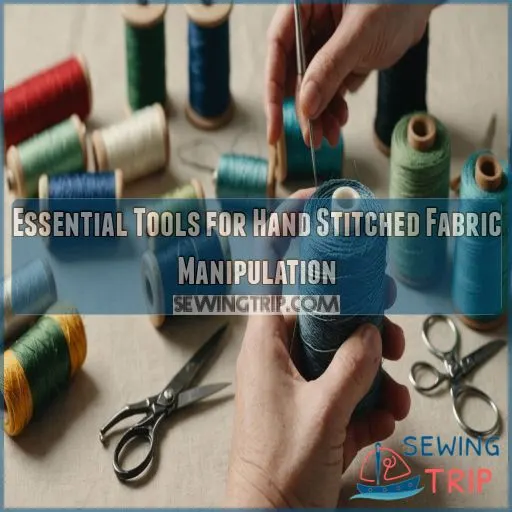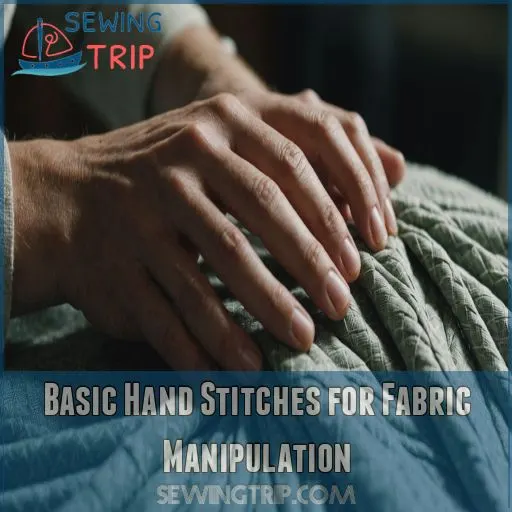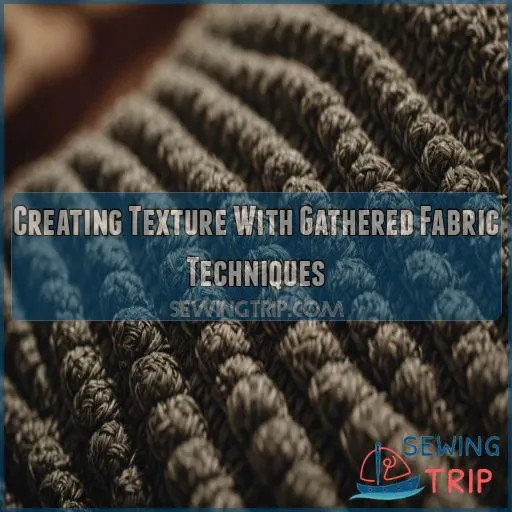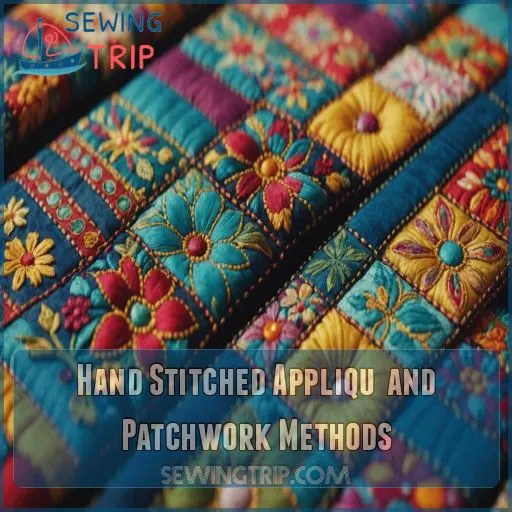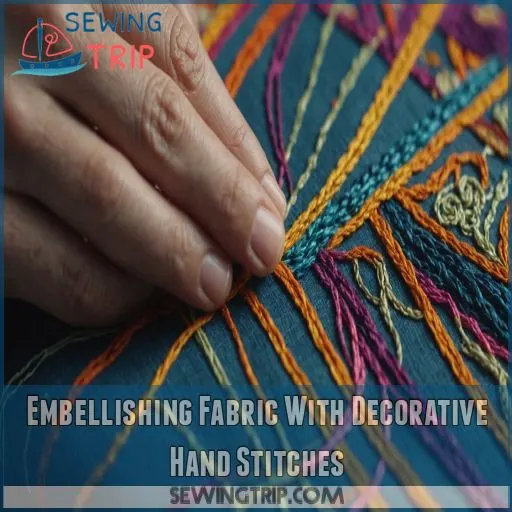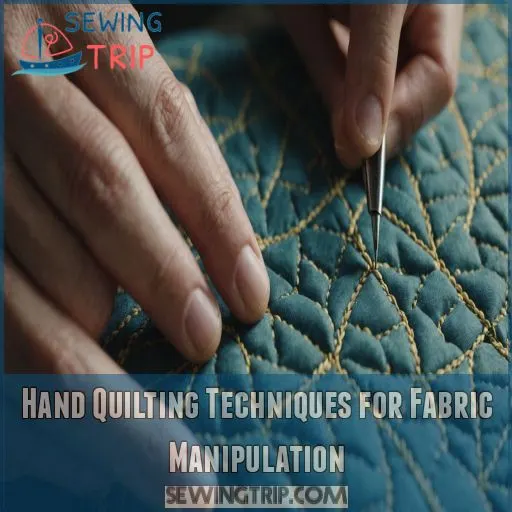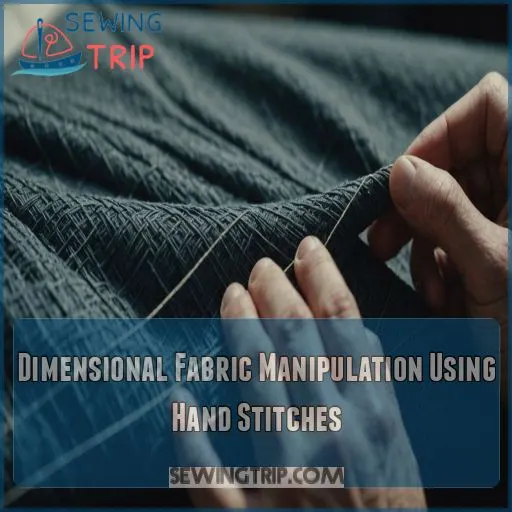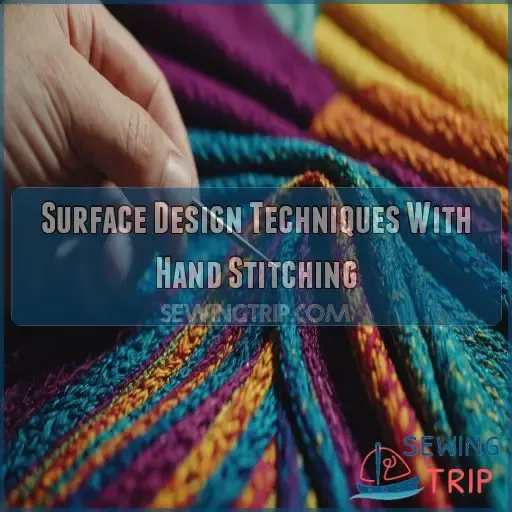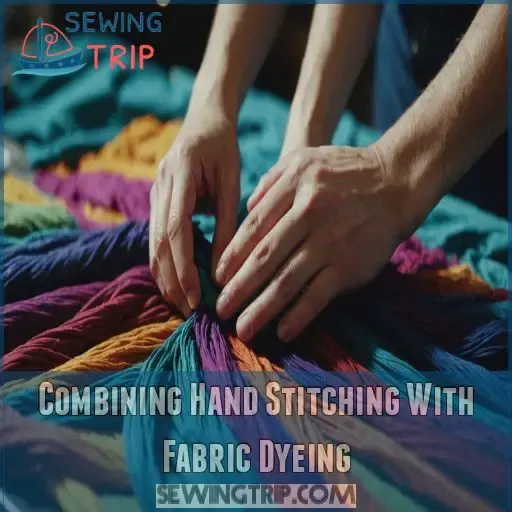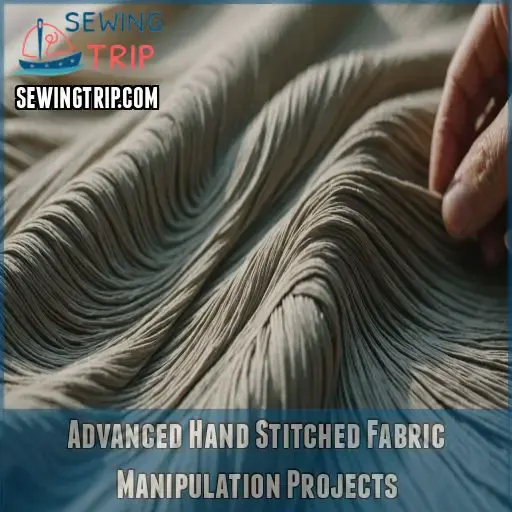This site is supported by our readers. We may earn a commission, at no cost to you, if you purchase through links.
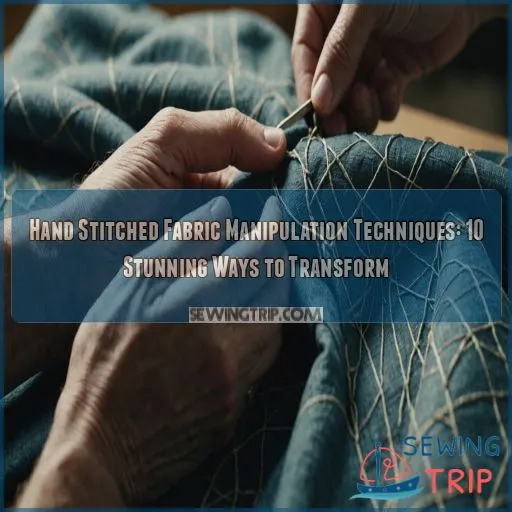
Hand stitched fabric manipulation techniques are your secret weapons for adding texture, dimension, and personality to any textile project.
From basic running stitches to intricate smocking patterns, you’ll discover a world of possibilities at your fingertips.
Imagine turning a flat piece of fabric into a rippling sea of ruffles or creating 3D flowers that seem to bloom right off the surface.
With just a needle, thread, and your imagination, you’ll be crafting one-of-a-kind pieces that’ll have everyone asking, "How’d you do that?"
Get ready to tap into your inner fabric artist – there’s a whole universe of textures waiting to be explored!
Table Of Contents
- Key Takeaways
- Essential Tools for Hand Stitched Fabric Manipulation
- Basic Hand Stitches for Fabric Manipulation
- Creating Texture With Gathered Fabric Techniques
- Hand Stitched Appliqué and Patchwork Methods
- Embellishing Fabric With Decorative Hand Stitches
- Hand Quilting Techniques for Fabric Manipulation
- Dimensional Fabric Manipulation Using Hand Stitches
- Surface Design Techniques With Hand Stitching
- Combining Hand Stitching With Fabric Dyeing
- Advanced Hand Stitched Fabric Manipulation Projects
- Frequently Asked Questions (FAQs)
- Conclusion
Key Takeaways
- You’re about to embark on a fabric adventure that will turn ordinary materials into extraordinary creations. With just a needle and thread, you’ll be crafting one-of-a-kind pieces that will have everyone asking, "How did you do that?" From basic running stitches to intricate smocking patterns, there’s a whole universe of textures waiting for you to explore.
- Get ready to become a fabric wizard with techniques like ruching, smocking, and pleating. You’ll be adding volume, dimension, and personality to your projects faster than you can say "needle and thread." It’s like giving your fabric a magic makeover – who knew you could transform a flat piece of cloth into a rippling sea of ruffles?
- Don’t be afraid to mix and match techniques to create your own unique style. Try combining sashiko embroidery with eco-printing, or experiment with fabric origami and ribbon embroidery. The sky’s the limit when it comes to hand-stitched fabric manipulation – let your creativity run wild and see what masterpieces you can create.
- Remember, practice makes perfect (or at least perfectly imperfect). You might prick your fingers a few times along the way, but trust us, the end result is worth it. Soon enough, you’ll be whipping up stunning textured landscapes, wearable art, and home decor pieces that will make your friends wonder if you’ve secretly become a fabric magician.
Essential Tools for Hand Stitched Fabric Manipulation
You’re about to start a fabric manipulation adventure, and having the right tools is like having a trusty sidekick by your side.
From needles that glide through fabric like butter to hoops that keep your work taut and ready for transformation, we’ll explore the essential gear that’ll turn your creative visions into tactile reality.
Needles and Thread Selection
Choosing the right needle-and-thread combo is like finding the perfect dance partners for your fabric.
You’ll want to match your needle size and thread weight to your project’s needs.
Consider the fabric’s fiber type when selecting your thread color and needle gauge.
For hand stitching and fabric manipulation, finer needles and threads often work best, especially when using natural dyes or working with delicate textile manipulations.
Fabric Choices and Preparation
Now that you’ve got your needles and thread sorted, let’s talk fabric! Your canvas is key in this creative journey.
Think about the weight and fiber content – will you go for sturdy cotton or flowy silk?
Don’t forget to pre-wash to avoid surprises later.
If you’re feeling adventurous, why not try natural dyeing or adding unique patches?
The fabric world’s your oyster – let’s make it shine!
Embroidery Hoops and Frames
Embroidery hoops and frames are your trusty sidekicks in the fabric manipulation game. They keep your fabric taut as a drum, allowing you to work your magic with precision.
Here’s why they’re essential:
- Maintain even tension across your fabric
- Prevent puckering and distortion
- Provide a stable work surface
- Allow easy access to both sides of your project
From pocket-sized hoops to floor-standing frames, there’s a perfect fit for every stitcher’s needs and project size.
Scissors and Cutting Tools
You’ve got your hoops and threads, but let’s slice into the real cutting edge of fabric manipulation – scissors and cutting tools!
Sharp, precise cuts are the secret sauce to stunning hand-stitched creations.
From classic shears to rotary cutters, each tool has its superpower.
Ever tried making prairie points with dull blades?
Talk about a fabric fiasco!
Let’s sharpen your cutting game and transform your crafting adventures.
Marking Tools and Templates
Let’s explore marking tools and templates – your secret weapons for fabric manipulation mastery. These handy helpers make sure your designs hit the mark every time.
From water-soluble pens to chalk wheels, you’ll find a tool for every fabric.
Don’t forget about templates – they’re lifesavers for creating intricate patterns like diamond pin tucks or honeycomb smocking. Keep your templates organized and you’ll be stitching up a storm in no time!
Basic Hand Stitches for Fabric Manipulation
You’re about to learn the power of basic hand stitches that’ll transform your fabric into a work of art.
These foundational techniques are your ticket to creating stunning textures, intricate details, and eye-catching embellishments that’ll make your projects truly one-of-a-kind.
Running Stitch and Its Variations
Now that you’ve got your tools ready, it’s time to master the running stitch – the backbone of hand sewing!
This versatile stitch is like the Swiss Army knife of fabric manipulation.
By varying its length, direction, density, and tension, you can create everything from delicate suffolk puffs to eye-catching twisted pleats.
Want to add some flair? Try transforming your running stitch into playful ribbon loops or adorable rabbit ears.
Backstitch for Strength and Detail
The unsung hero of hand stitching, the backstitch, packs a punch in both strength and detail.
You’ll find this versatile stitch indispensable for creating durable seams and adding intricate designs to your fabric creations.
Whether you’re crafting handmade gifts, fabric flowers, or exploring shell smocking, the backstitch’s got your back.
Its variations offer endless possibilities, allowing you to infuse your projects with personality and precision.
Master this stitch, and you’ll open up a world of fabric manipulation magic.
Chain Stitch for Decorative Lines
While backstitch provides strength, chain stitch adds a whole new dimension to your fabric manipulation toolkit.
This versatile stitch creates beautiful, flowing lines that can transform plain fabric into a work of art.
You’ll love how it forms delicate chains, perfect for outlining designs or creating decorative borders.
Play with different thread thicknesses and stitch lengths to achieve various effects.
It’s like drawing with thread!
French Knots for Texture and Accents
Chain stitches are lovely, but let’s add some pop! French knots are your secret weapon for instant texture and accents. You’ll love playing with knot variations, sizes, and densities to create stunning effects.
Try clustering them for a 3D look or scattering them like tiny stars.
Mix up colors for a confetti-like burst or stick to one shade for elegant simplicity. It’s like fabric origami – endlessly creative!
Blanket Stitch for Edges and Appliqué
Stitching enthusiasts, get ready to elevate your fabric game with the versatile blanket stitch! This powerhouse technique isn’t just for blankets – it’s perfect for securing edges and creating stunning appliqué designs.
Here’s why you’ll love it:
- Adds a decorative flair to simple quilts
- Creates clean, professional-looking edges
- Ideal for attaching appliqué shapes to quilt tops
- Easily adjustable for different fabric thicknesses
- Can be used to create unique textile sculptures
With practice, you’ll master this stitch and transform your projects!
Creating Texture With Gathered Fabric Techniques
Want to add some oomph to your fabric creations? Discover the magic of gathered fabric techniques that’ll transform flat surfaces into eye-catching masterpieces brimming with texture and dimension, just like the gathered fabric technique explained in this article.
Ruching for Volume and Dimension
Want to add some serious oomph to your fabric? Ruching is your go-to technique! This gathering method creates gorgeous volume and dimension, transforming flat fabric into a rippling sea of texture.
You’ll love how it adds visual interest to everything from cushions to clothing.
Ready to get started? Let’s explore ruching techniques that’ll have you controlling fabric like a pro in no time!
Smocking Patterns and Styles
Ruching’s voluminous charm sets the stage for its elegant cousin: smocking. This hand-stitching technique creates intricate patterns that’ll make your fabric sing.
You’ll love exploring classic diamond smocking or the whimsical lotus flower design.
With just a few tools and some practice, you’ll be transforming plain fabric into stunning textures.
Ready to explore the art of smocked tucks and mesmerizing patterns? Let’s get stitching!
Shirring With Elastic Thread
Shirring with elastic thread is like magic for your fabric! It’s a technique that’ll make you feel like a wizard, transforming flat cloth into stretchy, textured wonders.
You’ll love how it:
- Adds a touch of whimsy to your creations
- Gives you that satisfying "I made this!" feeling
- Creates a forgiving fit for various body types
- Lets you play with patterns and textures
Grab some elastic thread, and let’s turn your fabric into a work of art!
Pleating Techniques by Hand
Pleating by hand transforms fabric into stunning textures and shapes.
You’ll love exploring various techniques like knife pleats, box pleats, and accordion folds.
Each method creates unique patterns, from subtle elegance to bold statements.
Experiment with different fabric types to achieve the perfect drape and volume.
Don’t be afraid to mix it up – try centered tucks with bow ties or create intricate origami flowers for a touch of whimsy in your projects.
Ruffles and Flounces
Ruffles and flounces add a delightful touch of whimsy to your fabric creations.
You’ll love how these gathered techniques transform flat fabric into lively, three-dimensional textures.
From delicate silky grooves to bold statement pieces, there’s a ruffle for every project.
Why not try your hand at improv fabric folding or the echidna block?
With a bit of practice, you’ll be creating beaded origami-inspired ruffles that’ll make Rowan Mersh proud!
Hand Stitched Appliqué and Patchwork Methods
You’re about to discover the enchanting world of hand-stitched appliqué and patchwork, where fabric becomes your canvas and needle your brush.
Get ready to transform ordinary materials into extraordinary works of art as we explore five mesmerizing techniques that’ll have you stitching up a storm in no time.
Needle-turn Appliqué Technique
Mastery of needle-turn appliqué opens up a world of creative possibilities.
You’ll love this elegant technique that lets you add intricate designs to your fabric.
Start by choosing your appliqué fabric and sketching your design.
Then, carefully turn the edges under with your needle as you stitch, creating smooth curves and crisp points.
With practice, you’ll be crafting stunning hand-stitched details that’ll make your projects pop!
Reverse Appliqué for Layered Designs
Now, let’s flip the script with reverse appliqué! This technique’s like playing fabric peek-a-boo.
You’ll create stunning layered designs by:
- Stacking contrasting fabrics
- Stitching your desired pattern
- Carefully cutting away the top layer
Voilà! The bottom fabric peeks through, creating a mesmerizing effect. It’s perfect for adding depth to everything from cushions to quilts. Ready to give your projects a whole new dimension?
English Paper Piecing for Precise Shapes
While reverse appliqué adds depth, English Paper Piecing (EPP) brings precision to your fabric manipulation arsenal.
You’ll love how this technique lets you create intricate geometric shapes with razor-sharp edges.
It’s like fabric origami!
Start by choosing your paper templates and fabrics.
Cut your pieces precisely, leaving seam allowances.
Then, wrap and baste the fabric around each template.
Crazy Patchwork for Eclectic Designs
English Paper Piecing’s precision paves the way for its wild cousin: Crazy Patchwork. This eclectic technique lets you express your inner fabric artist!
Gather those colorful scraps and mix textures with abandon. Your design inspiration? Anything goes!
Stitch together odd shapes in a free-form frenzy, creating a one-of-a-kind masterpiece. It’s like quilting meets abstract art – a perfect way to express your unique style and use up your stash.
Broderie Perse for Intricate Floral Motifs
From eclectic patchwork, let’s bloom into Broderie Perse. You’ll fall in love with this intricate floral appliqué technique that’s been turning heads since the 17th century. It’s like painting with fabric – you’ll snip out beautiful blooms and stitch them onto your canvas.
Here’s your garden-to-fabric guide:
- Choose chintz or large-print florals
- Carefully cut around motifs
- Arrange your floral symphony
- Secure with invisible appliqué stitches
Embellishing Fabric With Decorative Hand Stitches
You’re about to discover a world of fabric magic with decorative hand stitches.
These beautiful techniques will transform your plain fabrics into stunning works of art, adding texture, depth, and personality to your creations.
Feather Stitch for Delicate Borders
Now that you’ve mastered appliqué, let’s add some flair to your borders!
The feather stitch is your go-to for creating delicate, nature-inspired edges.
It’s like drawing a whimsical vine with your needle and thread.
Play with different thread colors and stitch lengths to achieve various effects.
Herringbone Stitch for Texture and Pattern
Texture and pattern come alive with the versatile herringbone stitch! You’ll love how this V-shaped wonder adds depth to your fabric projects.
It’s a breeze to master – just alternate diagonal stitches to create a zigzag effect.
Try varying your thread colors or stitch lengths for unique looks.
From bohemian totes to chic table runners, the herringbone stitch is your ticket to eye-catching designs.
Bullion Knots for Dimensional Elements
Herringbone’s zigzags are eye-catching, but let’s raise the stakes with bullion knots! These little wonders add a pop of texture that’ll make your fabric sing. You’ll wrap thread around your needle to create raised, dimensional elements that bring your designs to life. It’s like adding tiny sculptures to your fabric canvas!
- Experiment with different knot lengths for varied effects
- Combine colors to create ombré or rainbow bullions
- Use bullions to form flower petals or animal fur textures
- Try curved bullions for flowing, organic shapes
Couching for Attaching Cords and Beads
Ready to level up your embroidery game? Couching is your secret weapon for adding dazzling dimension to your projects.
You’ll love how this technique lets you attach cords and beads with ease.
It’s like giving your fabric a stylish makeover! Play with different cord thicknesses and bead sizes to create eye-catching patterns. Mix and match colors for a truly unique look that’ll have everyone asking, "How’d you do that?
Satin Stitch for Smooth Filled Areas
Picture a silky smooth pond, rippling with color. That’s the magic of satin stitch! This versatile technique lets you fill areas with a luxurious sheen.
Here’s your guide to satin stitch mastery:
- Start with small shapes for practice
- Use a hoop to keep fabric taut
- Work in a consistent direction for even coverage
- Experiment with long and short stitches for shading
Ready to get started? Your fabric’s about to get a whole lot smoother!
Hand Quilting Techniques for Fabric Manipulation
You’re about to discover how hand quilting can transform your fabric into a work of art.
From rustic charm to raised designs, these techniques will add depth and texture to your projects that’ll make everyone want to reach out and touch them.
Big Stitch Quilting for Rustic Charm
Now, let’s explore the charm of big stitch quilting!
This rustic technique adds a cozy, homespun feel to your projects.
You’ll use thicker thread and longer stitches, creating bold patterns that catch the eye.
It’s perfect for beginners and speedy crafters alike.
Choose earthy color palettes and simple designs to enhance that vintage vibe.
With big stitch quilting, you’ll transform plain fabrics into stunning, tactile works of art in no time!
Traditional Hand Quilting Patterns
While traditional hand quilting patterns might seem old-fashioned, they’re actually treasure troves of inspiration for fabric manipulation.
You’ll find a world of quilt block designs, from simple geometric shapes to intricate floral motifs.
These vintage patterns often tell stories of quilting history and community quilts.
Don’t be afraid to put your own spin on them – modern adaptations can breathe new life into time-honored techniques, creating stunning textures that’ll make your projects pop!
Trapunto for Raised Designs
After mastering traditional hand quilting patterns, you’re ready to elevate your designs—literally! Trapunto, the art of creating raised designs, adds a luxurious 3D effect to your quilts. You’ll stuff areas between stitched outlines, creating eye-catching texture. It’s like giving your quilt a secret superpower—turning flat fabric into a touchable masterpiece!
- Choose lightweight batting for subtle raises
- Experiment with wool roving for extra loft
- Try metallic threads for a touch of glamour
- Combine trapunto with shadow quilting
- Use trapunto to highlight focal points
Kantha Quilting for Layered Textures
Moving from raised designs, let’s explore the mesmerizing world of Kantha quilting. This traditional technique transforms vintage textiles into stunning layered masterpieces by exploring the history of sewing.
You’ll fall in love with the rhythmic Kantha stitches that create intricate patterns and textures. Experiment with bold color combinations to breathe new life into old fabrics.
It’s like giving your quilt a cozy hug! Ready to turn your grandma’s forgotten saris into a work of art?
Boro-inspired Patching and Mending
Embrace the beauty of imperfection with Boro-inspired patching and mending.
This centuries-old Japanese technique transforms worn textiles into stunning works of art.
You’ll fall in love with the rustic charm of visible mending as you layer patches and Sashiko stitching.
It’s like giving your fabric a second life, telling a story of resilience and resourcefulness.
Get ready to upcycle with style and connect with textile history!
Dimensional Fabric Manipulation Using Hand Stitches
Ready to take your fabric manipulation skills to new heights?
Discover how simple hand stitches can transform flat fabric into stunning 3D creations, from charming Suffolk puffs to intricate fabric origami that’ll make your projects pop, check out basic hand stitches.
Suffolk Puffs (yo-yos) for 3D Elements
Get ready to explore the charming world of Suffolk puffs, also known as yo-yos! These delightful 3D fabric elements add a whimsical touch to your projects.
You’ll love how versatile they are:
- Create tiny puffs for delicate accents or large ones for bold statements
- Experiment with different fabric types for varied textures and drapes, checking out the fabric dictionary for inspiration
- Combine puffs in patterns to form flowers, geometric shapes, or even quilts
Ready to transform your fabric into a tactile wonderland?
Folded Fabric Flowers and Rosettes
Transform your fabric into stunning 3D blooms with folded flowers and rosettes!
These eye-catching embellishments add depth and charm to any project.
You’ll love experimenting with different fabric types, from silky petals to rustic burlap blooms.
Whether you’re adorning a pillow or creating a unique bouquet, these techniques offer endless possibilities.
Let your creativity blossom as you master the art of fabric flower making!
Fabric Origami Techniques
Fabric origami techniques bring paper-folding artistry to your textile projects. You’ll craft stunning 3D textures and geometric shapes that’ll make your creations pop.
Here’s why you’ll love it:
- It’s a real conversation starter
- Your projects become one-of-a-kind masterpieces
- It’s oddly satisfying (like perfectly folding a fitted sheet!)
With just your hands and some fabric, you’re sculpting wearable art. Who knew your origami skills would come in handy beyond paper cranes?
Tucks and Pintucks for Subtle Texture
Now that you’ve mastered fabric origami, let’s explore the subtle art of tucks and pintucks. These tiny folds can add incredible texture to your projects. You’ll love how they transform plain fabric into something extraordinary!
| Tuck Type | Description | Best Fabrics | Tools Needed |
|---|---|---|---|
| Pin Tucks | Narrow, closely spaced | Lightweight, crisp | Fine needle, thread |
| Space Tucks | Wider gaps between folds | Medium-weight | Ruler, chalk |
| Blind Tucks | Hidden on wrong side | Heavier fabrics | Pins, iron |
| Graduated Tucks | Varying widths | Any weight | Measuring tape |
Ready to give it a try? Let’s get tucking!
Fabric Manipulation Using Interfacing
Tucks are lovely, but let’s explore a game-changer in fabric manipulation: interfacing.
This unsung hero can give your projects a whole new dimension.
You’ll love how it adds structure and shape to your hand-stitched creations.
From stiff to fusible, there’s an interfacing for every need.
It’s like giving your fabric a secret superpower – suddenly, your designs stand up and take notice!
Surface Design Techniques With Hand Stitching
You’re about to discover a world of beautiful surface design techniques that’ll transform your fabric into works of art.
From the geometric precision of blackwork to the delicate blooms of ribbon embroidery, these hand-stitching methods will add depth, texture, and personality to your creations.
Sashiko Embroidery Patterns
Get into the meditative world of sashiko embroidery, where simple running stitches create stunning geometric patterns. You’ll fall in love with this traditional Japanese technique that’s both functional and beautiful.
Let’s explore the essentials of sashiko:
- Sashiko history: From humble mending to decorative art
- Modern sashiko: Blending tradition with contemporary designs
- Sashiko for beginners: Start with basic patterns like waves or diamonds
Ready to stitch your stress away? Grab some indigo fabric and white thread – your sashiko journey begins now!
Blackwork Embroidery for Geometric Designs
Venture into the mesmerizing world of blackwork embroidery, where geometric patterns reign supreme.
This centuries-old technique, once used to adorn Tudor clothing, has evolved into a modern art form.
You’ll create stunning designs using black thread on white fabric, though today’s artists often experiment with vibrant colors too.
It’s like drawing with thread – precise, elegant, and utterly addictive.
Ready to channel your inner royal embroiderer?
Crewel Work With Wool Thread
For centuries, crewel work has been transforming fabric into stunning art.
You’ll love working with luscious wool threads to create rich, textured designs.
Experiment with various stitch types and color blending techniques to bring your fabric to life, using loop stitching techniques.
From traditional Jacobean patterns to modern abstract creations, crewel embroidery offers endless possibilities.
It’s like painting with thread – your fabric becomes a canvas for your imagination!
Cutwork and Drawn Thread Work
Now let’s shift our focus from wool threads to the intricate world of cutwork and drawn thread work. These techniques create stunning openwork designs that’ll make your fabric truly unique. You’ll be amazed at how removing threads can add such elegance to your projects!
Here’s what you need to know about cutwork and drawn thread work:
- It’s like creating lace with your bare hands
- Perfect for adding an heirloom touch to linens
- Combines well with other embroidery styles
- Requires patience, but the results are breathtaking
- Can transform simple fabric into a work of art
Ribbon Embroidery for Floral Motifs
The delicate art of ribbon embroidery blooms with endless possibilities.
You’ll fall in love with creating lifelike floral motifs using silky ribbons and simple stitches.
Experiment with various ribbon widths and colors to bring your garden-inspired designs to life.
Try silk ribbon for peonies, satin for roses, and organza for delicate baby’s breath.
It’s like painting with fabric – your needle becomes the brush!
Combining Hand Stitching With Fabric Dyeing
You’re about to discover how hand stitching and fabric dyeing can join forces to create breathtaking textile art to learn embroidery basics.
Get ready to explore your creativity as we explore five exciting techniques that’ll transform plain fabrics into vibrant, one-of-a-kind masterpieces.
Shibori Resist Dyeing Techniques
Shibori, the ancient Japanese art of resist dyeing, is like painting with fabric folds. You’ll create mesmerizing patterns by manipulating cloth before dipping it in dye. It’s a dance between control and unpredictability, where each piece becomes a unique masterpiece. Ready to try this textile adventure?
- Experiment with itajima (folding and clamping) for geometric designs
- Try arashi (pole-wrapping) for diagonal patterns
- Explore kumo (binding) for spider-web-like effects
Tie-dye Patterns Using Hand Stitches
Tie-dye’s vibrant patterns aren’t just for hippie festivals anymore!
You can create stunning, one-of-a-kind designs using hand stitches.
By combining traditional tie-dye techniques with strategic stitching, you’ll open up a world of artistic possibilities.
Here’s a quick guide to get you started:
| Stitch Type | Effect | Difficulty |
|---|---|---|
| Running | Linear patterns | Easy |
| Gathering | Circular designs | Medium |
| Zigzag | Geometric shapes | Hard |
| Knots | Starbursts | Advanced |
Ready to get started? Let’s transform that plain fabric into a wearable masterpiece!
Batik-inspired Wax Resist Methods
Batik’s ancient art meets modern hand-stitching in this wax-resist technique.
You’ll love creating intricate patterns by applying hot wax to fabric before dyeing.
Prep your cloth, then sketch your design with melted wax.
Get creative with resist patterns – try traditional motifs or invent your own!
Once dyed, remove the wax to reveal stunning contrasts.
It’s like magic, but you’re the magician crafting unique, eye-catching textiles.
Eco-printing With Natural Materials
While wax resist methods offer unique patterns, eco-printing lets you harness nature’s beauty directly on fabric.
It’s like pressing a forest floor onto your cloth!
Gather leaves, flowers, and bark, then sandwich them between fabric layers.
As you steam or simmer, watch Mother Nature’s pigments transfer, creating stunning botanical prints.
It’s a sustainable way to add one-of-a-kind artistry to your hand-stitched projects.
Ready to become a fabric alchemist?
Embroidery on Hand-dyed Fabrics
Ever wondered how to make your embroidery pop? Try stitching on hand-dyed fabrics! It’s like painting on a canvas that’s already bursting with color. You’ll be amazed at how your stitches dance across the vibrant background.
Choose threads that complement or contrast with your dyed fabric for stunning effects. Whether you’re embellishing a tie-dye tee or adding flair to a batik scarf, this technique will take your needlework to new heights.
Advanced Hand Stitched Fabric Manipulation Projects
You’ve mastered the basics, now it’s time to take your hand-stitched fabric manipulation skills to the next level.
These advanced projects will challenge your creativity and showcase your newfound expertise,
turning simple fabrics into stunning works of art that’ll make your friends wonder if you’ve secretly become a fabric magician.
Creating Textured Fabric Landscapes
You’ve mastered fabric dyeing, now it’s time to paint with thread! Creating textured fabric landscapes lets you express your inner artist. Imagine stitching rolling hills, towering mountains, and babbling brooks – all with your own two hands.
- Feel the satisfaction of bringing a scene to life, stitch by stitch
- Experience the joy of blending colors and textures to create depth
- Revel in the meditative process of slow, purposeful stitching
- Delight in surprising yourself with your own creativity
Hand Stitched Fabric Jewelry Making
Creating wearable art with fabric jewelry opens up a world of endless possibilities.
Transform your style by crafting unique pieces that showcase your personality.
From elegant fabric-covered beads to intricate embroidered pendants, you’ll be turning heads in no time.
Ready to get started?
Start with simple fabric earrings, then work your way up to statement necklaces using upcycled materials.
Let’s get creative and make some fabulous, one-of-a-kind accessories!
Fabric Book Covers With Manipulated Textures
Moving from jewelry to larger canvases, let’s explore fabric book covers with manipulated textures.
These aren’t your grandma’s boring book jackets!
By applying various stitching techniques, you’ll transform plain covers into tactile works of art.
Think raised embroidery, pleated accents, or even miniature fabric sculptures.
It’s like giving your favorite reads a cozy, handcrafted hug.
Ready to make your bookshelf the talk of the town?
Wearable Art Using Multiple Techniques
Picture yourself as a walking canvas, adorned with your own textile masterpiece.
By combining multiple hand-stitching techniques, you’ll create wearable art that’s truly one-of-a-kind.
Mix shibori-dyed fabric with intricate embroidery, or layer appliqué over smocked sections for texture.
Don’t be afraid to experiment – your unique vision might just spark a sustainable fashion revolution.
Home Decor Items With Layered Textures
From wearable art to your living space, it’s time to transform your home!
Imagine sinking into a couch adorned with cushions boasting intricate layered textures.
You can create these stunning pieces using upholstery fabric and upcycled materials.
Mix techniques like smocking, appliqué, and embroidery to craft DIY cushion covers that double as textile art.
Your guests won’t believe you made these masterpieces yourself – they’re that impressive!
Frequently Asked Questions (FAQs)
What are fabric manipulation techniques?
You’ll love fabric manipulation techniques! They’re your secret weapon for transforming plain materials into stunning textures.
With pleats, gathers, tucks, and more, you’ll craft unique designs that’ll make your projects pop.
Get ready to explore your creativity!
What is the slashing technique of fabric?
Imagine slashing open a jacket to reveal a vibrant lining.
That’s the essence of slashing! You’re cutting through layers of fabric, exposing contrasting colors or textures underneath.
It’s like creating secret windows in your garments.
What is cloth manipulation?
Cloth manipulation is your creative playground!
It’s the art of transforming fabric through various techniques, adding texture, dimension, and personality to your projects.
You’re basically sculpting with cloth, turning flat fabrics into eye-catching masterpieces.
How to manipulate denim fabric?
Transform your denim with distressing, bleaching, or dyeing for a fresh look.
Try embroidery, appliqué, or patchwork to add personality.
Don’t forget fraying edges or creating rips for that perfectly worn-in vibe.
Let your creativity shine!
How long does hand stitched fabric manipulation typically take?
You’ll spend an eternity on hand-stitched fabric manipulation! Kidding aside, it typically takes hours to days, depending on your project’s complexity.
You’re in control of the pace, so don’t rush.
It’s your chance to innovate and master the craft.
Can these techniques be applied to all fabric types?
While most techniques work on various fabrics, some are better suited for specific materials.
Don’t be afraid to push boundaries and create something unique!
Your creativity’s the limit! Experiment with different textures and weights to discover what works best.
What are common mistakes in hand stitched fabric manipulation?
Isn’t it ironic? You’re trying to create beauty, yet common blunders can unravel your efforts.
Don’t rush, use proper tension, and choose the right needle.
Your fabric’s crying for attention – listen carefully and stitch mindfully.
How to care for hand manipulated fabric items?
Treat your fabric creations like cherished friends.
Handle with care, wash gently by hand, and store in a cool, dry place.
Avoid harsh chemicals and direct sunlight.
Regular TLC will keep your handmade treasures looking fabulous for years to come!
Are there eco-friendly options for fabric manipulation materials?
Dude, you’re in luck! You can totally rock eco-friendly fabric manipulation.
Try upcycling old clothes, using natural dyes, or opting for organic fabrics.
You’ll be a green guru in no time, creating sustainable art with your hands.
Conclusion
You’ve just discovered a treasure trove of hand stitched fabric manipulation techniques that’ll revolutionize your crafting game.
From creating 3D flowers to intricate smocking patterns, you’re now armed with the skills to transform any piece of fabric into a work of art.
With these stunning techniques at your fingertips, you’ll be turning heads and inspiring others in no time. So grab that needle and thread – your fabric adventure awaits!

